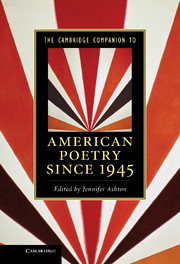27 results
Chapter 15 - Ecology, Ethics, and the Apocalyptic Lyric in Recent American Poetry
- from Part II - American Apocalypse in (and out of) History
-
-
- Book:
- Apocalypse in American Literature and Culture
- Published online:
- 03 December 2020
- Print publication:
- 17 December 2020, pp 199-211
-
- Chapter
- Export citation
Chapter 15 - Conceptual Writing
- from Part III - Digital Revolutions
-
-
- Book:
- American Literature in Transition, 2000–2010
- Published online:
- 14 December 2017
- Print publication:
- 28 December 2017, pp 224-236
-
- Chapter
- Export citation
Acknowledgments
-
- Book:
- The Cambridge Companion to American Poetry since 1945
- Published online:
- 05 January 2013
- Print publication:
- 08 February 2013, pp xiii-xiv
-
- Chapter
- Export citation
15 - Poetry of the Twenty-First Century:
-
-
- Book:
- The Cambridge Companion to American Poetry since 1945
- Published online:
- 05 January 2013
- Print publication:
- 08 February 2013, pp 216-230
-
- Chapter
- Export citation
The Cambridge Companion to American Poetry since 1945 - Title page
-
-
- Book:
- The Cambridge Companion to American Poetry since 1945
- Published online:
- 05 January 2013
- Print publication:
- 08 February 2013, pp v-v
-
- Chapter
- Export citation
Series page
-
- Book:
- The Cambridge Companion to American Poetry since 1945
- Published online:
- 05 January 2013
- Print publication:
- 08 February 2013, pp iii-iv
-
- Chapter
- Export citation
Copyright page
-
- Book:
- The Cambridge Companion to American Poetry since 1945
- Published online:
- 05 January 2013
- Print publication:
- 08 February 2013, pp vi-vi
-
- Chapter
- Export citation
Chronology of Publications and Events
-
- Book:
- The Cambridge Companion to American Poetry since 1945
- Published online:
- 05 January 2013
- Print publication:
- 08 February 2013, pp xv-xxx
-
- Chapter
- Export citation
Contents
-
- Book:
- The Cambridge Companion to American Poetry since 1945
- Published online:
- 05 January 2013
- Print publication:
- 08 February 2013, pp vii-viii
-
- Chapter
- Export citation
1 - Periodizing Poetic Practice since 1945
-
-
- Book:
- The Cambridge Companion to American Poetry since 1945
- Published online:
- 05 January 2013
- Print publication:
- 08 February 2013, pp 1-15
-
- Chapter
- Export citation
The Cambridge Companion to American Poetry since 1945 - Half title page
-
- Book:
- The Cambridge Companion to American Poetry since 1945
- Published online:
- 05 January 2013
- Print publication:
- 08 February 2013, pp i-ii
-
- Chapter
- Export citation
Notes on Contributors
-
-
- Book:
- The Cambridge Companion to American Poetry since 1945
- Published online:
- 05 January 2013
- Print publication:
- 08 February 2013, pp ix-xii
-
- Chapter
- Export citation
Index
-
- Book:
- The Cambridge Companion to American Poetry since 1945
- Published online:
- 05 January 2013
- Print publication:
- 08 February 2013, pp 231-238
-
- Chapter
- Export citation

The Cambridge Companion to American Poetry since 1945
-
- Published online:
- 05 January 2013
- Print publication:
- 08 February 2013
26 - Lyric, gender, and subjectivity in modern and contemporary women's poetry
-
-
- Book:
- The Cambridge History of American Women's Literature
- Published online:
- 28 September 2012
- Print publication:
- 24 May 2012, pp 515-538
-
- Chapter
- Export citation
Chapter 4 - Modernism's old literalism: Pound, Williams, Zukofsky, and the objectivist critique of metaphor
-
- Book:
- From Modernism to Postmodernism
- Published online:
- 22 September 2009
- Print publication:
- 05 January 2006, pp 119-145
-
- Chapter
- Export citation
Chapter 1 - Gertrude Stein for anyone
-
- Book:
- From Modernism to Postmodernism
- Published online:
- 22 September 2009
- Print publication:
- 05 January 2006, pp 30-66
-
- Chapter
- Export citation
Chapter 5 - Authorial inattention: Donald Davidson's literalism, Jorie Graham's Materialism, and cognitive science's embodied minds
-
- Book:
- From Modernism to Postmodernism
- Published online:
- 22 September 2009
- Print publication:
- 05 January 2006, pp 146-176
-
- Chapter
- Export citation
Chapter 3 - Laura (Riding) Jackson and T=H=E N=E=W C=R=I=T=I=C=I=S=M
-
- Book:
- From Modernism to Postmodernism
- Published online:
- 22 September 2009
- Print publication:
- 05 January 2006, pp 95-118
-
- Chapter
- Export citation
Index
-
- Book:
- From Modernism to Postmodernism
- Published online:
- 22 September 2009
- Print publication:
- 05 January 2006, pp 199-201
-
- Chapter
- Export citation



